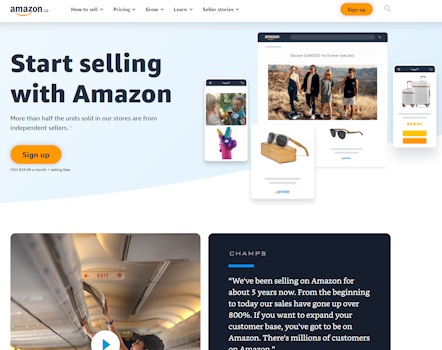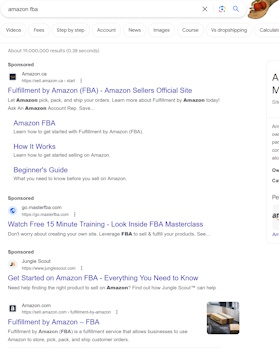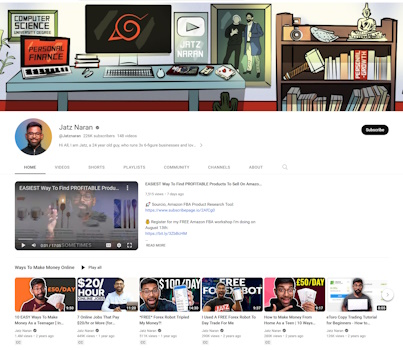The Amazon FBA Fees
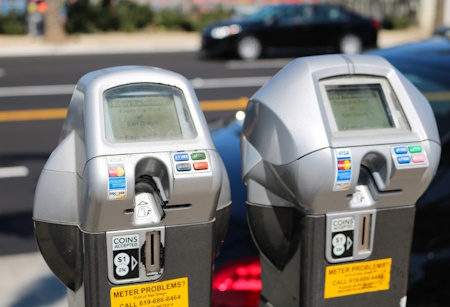
Amazon FBA fees are usually discussed as a side issue, but you should really take notice of them. If you sell your product too low you can easily start to lose money with Amazon FBA (an intro to Amazon FBA is here).
But. There are also fees very indirect that we all forget about.
So as of writing the fees for Amazon FBA are (and can be):
Product Sourcing Costs:
Manufacturing or wholesale costs: The cost of producing or purchasing the products you intend to sell.
Shipping and transportation fees: The cost of getting your products from the manufacturer or supplier to Amazon's fulfillment centers.
Amazon Fees:
Referral fees: A percentage of the item's sale price that Amazon charges as a commission for facilitating the sale.
Variable closing fees: A per-item fee for media products like books, music, and videos.
FBA fulfillment fees: Charges for storage, picking, packing, and shipping your products to customers.
Monthly storage fees: Charges for storing products in Amazon's warehouses, particularly for items that have been there for an extended period.
Prep and Packaging Costs:
Packaging materials: Costs for boxes, labels, bubble wrap, and other materials needed to prepare your products for shipment to Amazon.
Shipping to Amazon:
Inbound shipping costs: The expense of sending your products from your location to Amazon's fulfillment centers. This includes shipping, freight, and any handling charges.
Product Photography and Content Creation:
Professional product photography: The cost of high-quality images for your product listings.
Copywriting and content creation: Expenses for creating persuasive and informative product descriptions, bullet points, and keywords.
Marketing and Advertising:
Amazon PPC advertising: Expenses related to running pay-per-click campaigns on Amazon to promote your products.
External marketing: Costs associated with social media advertising, influencer partnerships, and other external promotional efforts. Check out our main consideration for paid placement here).
Software and Tools:
Amazon FBA tools: Expenses for software that assists with product research, inventory management, and analytics.
Inventory management software: Tools that help you track and manage your inventory levels and reorder points.
Brand Registry and Trademarks:
Brand registry fees: If you want to enroll in Amazon's Brand Registry program to protect your brand and gain additional benefits.
Trademark registration: Costs associated with registering your brand's trademark, which can provide legal protection.
Returns and Customer Service:
Refunds and returns: Expenses related to processing refunds and handling returned items.
Customer service: Costs for providing customer support and addressing inquiries.
Legal and Regulatory Compliance:
Compliance fees: Expenses related to ensuring your products meet regulatory standards and requirements. You could also include insurance here.
Taxes:
Sales tax: Depending on your jurisdiction and where you have a tax obligation, you may need to account for sales tax on your sales.
Miscellaneous Costs:
Bank fees: Charges for currency conversion, international transactions, or transferring funds from Amazon to your bank account.
Professional services: Costs associated with hiring professionals such as accountants or lawyers for business-related tasks.
The Amazon FBA fees can be large initially and then smaller over time.

Not all of these fees you will incur monthly or at every sale. So you might get a yearly web hosting package. Or you might buy a software package outright. But. you still have to calculate how much money you spent in that year. Even a $120/ year hosting package is still $10/month you have to find.
When you read through the fees you will notice: A referral fee and fulfillment fee. These sound the same, so what are they?
- Referral Fee:
A referral fee is a commission that Amazon charges sellers for facilitating the sale of their products on their platform. This fee is a percentage of the item's sale price (including the item price and any shipping or gift wrapping charges, but excluding any taxes collected through Amazon tax calculation services). The referral fee varies depending on the category of the product you're selling. Different categories have different fee structures based on the perceived cost of fulfillment and customer service for those types of products.
For example, if you're selling a product with a sale price of $20 and the referral fee for that category is 15%, your referral fee would be $20 * 0.15 = $3.
- FBA Fulfillment Fee:
The FBA fulfillment fee is the cost Amazon charges for the storage, picking, packing, and shipping of your products to customers. This fee covers the operational costs associated with handling your products within Amazon's fulfillment centers. The FBA fulfillment fee varies depending on the size and weight of the product, as well as the time of year (Amazon often adjusts these fees during peak shopping seasons).
FBA fulfillment fees take into account the dimension and weight tier of your product. For example, a standard-size product weighing between 1 lb and 2 lb might have a different fulfillment fee than an oversized product weighing between 2 lb and 3 lb. These fees are generally structured to cover the costs associated with processing and delivering the product to the customer.
$20 product case study
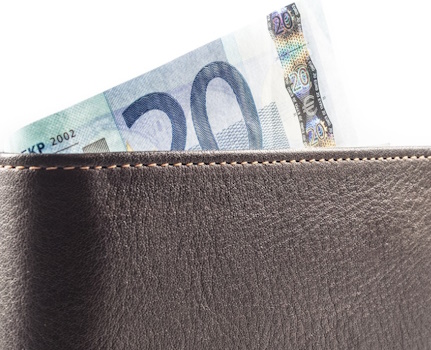
What happens if you are trying to sell a product for $20? What would be the total in fees from intial startup (we are assuming standard area shipping, and one product at one size and weight)?
Product Sourcing Costs:
Manufacturing cost: $5
Shipping to Amazon: $2
Amazon Fees:
Referral fee (15% of $20): $3
FBA fulfillment fee: $5.25 (Standard size)
Prep and Packaging Costs:
Packaging materials: $1
Shipping to Amazon:
Inbound shipping costs: $0 (for this example, as we're not considering inbound shipping costs)
Product Photography and Content Creation:
Professional product photography: $100 (one-time cost)
Copywriting and content creation: $50 (for one-time creation)
Marketing and Advertising:
Amazon PPC advertising: $30 (monthly budget)
Software and Tools:
Amazon FBA tools and software: $20 (monthly subscription)
Brand Registry and Trademarks:
Brand registry fees: $0 (for this example)
Returns and Customer Service:
Refunds and returns: $2 (estimated cost per returned item)
Customer service: $0 (assuming you handle this yourself)
Legal and Regulatory Compliance:
Compliance fees: $0 (for this example)
Taxes:
Sales tax: Varies based on your location and sales, not included in this breakdown.
Miscellaneous Costs:
Bank fees: $0 (for this example)
Professional services: $0 (for this example)
Total Expenses:
Product sourcing costs: $5 + $2 = $7
Amazon fees: $3 + $5.25 = $8.25
Prep and packaging costs: $1
Photography and content creation: $100 + $50 = $150 (one-time cost)
Marketing and advertising: $30
Software and tools: $20
Returns and customer service: $2 (estimated cost per returned item)
Total expenses: $7 + $8.25 + $1 + $150 + $30 + $20 + $2 = $218.25
Profit Calculation:
Selling price: $20
Total expenses: $218.25
Gross profit per unit: $20 - $218.25 = -$198.25
In this example, the total expenses exceed the selling price of the product, resulting in a negative gross profit. This emphasizes the importance of accurately assessing costs, considering pricing strategies, and targeting products with a healthy profit margin. Remember that this is a simplified example, and the actual expenses and profits can vary widely based on your specific circumstances.
Thoughts?

When you look at costs, there are a couple of main points to consider:
1. you will find that Amazon will take about $8 just through fees- straight away. Now you are down to $12
2. buying the actual thing and shipping to Amazon can take up $7. Now you are down to $5.
How are you going to advertise? Buying clicks will drop the profit made.
So now you have to think, how do I increase profitability? I believe it was said there are 3 main ways to do this:
- increase amount bought
- increase frequency of buying
- raise prices/ reduce costs
The only way you can easily do point one and two is to have your own website/ customer funnel to allow contact with customers. Raising prices is actually can be really easy- sometimes a more costly product sells more. Another way to raise prices is to have another product and this is what most FBA sellers do to try and reduce Amazon FBA fees indirectly. If you have 2 $20 products that are similar to each other and can be cross referred then you start to see the benefits of having a list/ consumer data to help you sell more.
Reducing costs will only work if you know what is going out, if you bulk order etc. Reducing costs does not mean reducing your sales price- as we can see above. You will need to sell more (or sell more different products) to recoup the costs of a lower priced item. A really cool simple way to reduce costs is to have good customer service. This will reduce refunds and also allow you to tweak products according to the feedback that you get.
7 ways that can affect the profitability of your FBA store

The profitability of using Amazon FBA can vary widely depending on several factors, and it's not accurate to make a blanket statement that FBA is or isn't profitable in the long run. Whether FBA is profitable for you in the long run depends on your specific circumstances, strategies, and the way you manage your business. Here are some considerations:
- Product Choice: The type of products you choose to sell significantly impacts your profitability. Selecting products with high demand, healthy profit margins, and manageable competition is essential.
- Pricing Strategy: Setting the right prices for your products is crucial. If your prices are too low, you might struggle to cover expenses, while prices that are too high might deter potential customers.
- Competition: FBA has a vast number of sellers, which can lead to competition. If you're selling in highly competitive niches, it might be more challenging to achieve significant profitability. Go on Amazon FBA training courses and they always suggest that you find what is selling and then sell for less- or sell the same thing (this, btw, is not a good idea).
- Expenses: Thoroughly understanding and managing your expenses, including sourcing, Amazon fees, advertising costs, and other overhead, is essential for maintaining profitability.
- Marketing and Promotion: How effectively you market and promote your products, both on and off Amazon, plays a role in generating sales and profitability.
- Operational Efficiency: Efficiently managing inventory, order fulfillment, customer service, and other operational aspects can impact your overall costs and profitability.
- Market Trends: External factors such as market trends, seasonality, and changes in customer preferences can influence the demand for your products.
Long-Term Potential:
While achieving profitability in the short term is important, many successful FBA sellers focus on building sustainable long-term businesses. Over time, as you gain experience, refine your strategies, and optimize your processes, you may find ways to increase profitability.
Key Considerations:
- Diversification: Relying solely on one product or one marketplace can be risky. Many sellers diversify their product offerings and consider expanding to other platforms beyond Amazon. there are many a story of Amazon shutting down stores/ products because they have violated some policy.
- Constant Learning: The e-commerce landscape is ever-changing. Staying informed about market trends, Amazon's policies, and best practices is crucial for adapting to new challenges and opportunities.
- Value Proposition: Offering unique value through product differentiation, quality, branding, or customer service can help you stand out and maintain profitability.
- Scaling Thoughtfully: Scaling your business should be approached thoughtfully to ensure that increased sales don't lead to proportionally higher expenses.
Remember also that Amazon is a search engine. Want to know what some of the things Amazon search looks for in placement? Check out the Amazon SEO page here.
By Jasonera.com- Copyright © All rights reserved. About. Updates. Disclaimer. Privacy. Mission/ Vision. FAQ
